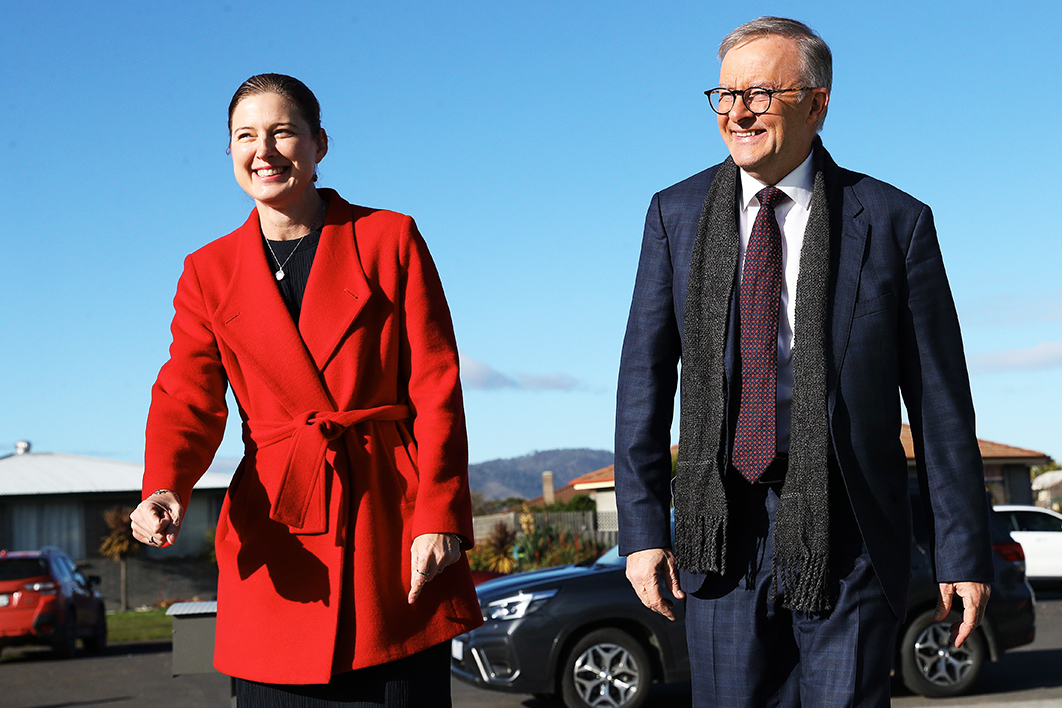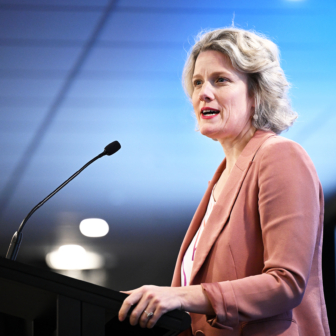For almost a decade the Coalition government insisted the states and territories had sole responsibility for ensuring that Australians on the lowest incomes had a place to call home. Even at the height of the pandemic — when business, unions, advocacy groups and independent experts called with one voice for federal investment in social housing and cash was pouring out of Treasury coffers — the pleas for a federal investment were ignored.
As a result, getting access to social housing, whether it’s public housing provided by state authorities or community housing provided by not-for-profits, is harder than ever. The first tranche of 2021 census data shows that social housing’s share of all dwellings has fallen below 4 per cent Australia-wide, continuing a steady decline over more than two decades.
When Scott Morrison opted instead to subsidise property owners through the HomeBuilder program, the states were forced to go it alone. Victoria set the pace in 2020 with the $5.3 billion Big Housing Build, a plan to construct 12,000 new dwellings and refurbish 23,000 existing social housing properties. Queensland soon came to the party with its $1.8 billion Housing Investment Growth Initiative, promising 6365 new homes over four years, and the WA government committed $2.1 billion to deliver 3300 new homes, adding another $408 million in its 2022 budget.
Labor-run states weren’t alone. The largest per capita investment was Tasmania’s $615 million commitment to construct 3500 new social houses by 2027 (funded in part by senator Jacqui Lambie’s success in negotiating a waiver of the state’s historical Commonwealth housing debt.)
South Australia and New South Wales are building too, though their construction programs will mostly replace old, rundown public housing, producing little gain in dwelling numbers.
The total state effort amounts to about $10 billion. According to housing expert Hal Pawson, the states will build more social housing over the next three years than Australia saw in the previous decade. Presenting an analysis by the UNSW City Futures Research Centre at this month’s Affordable Housing Summit in Melbourne, Pawson said that these programs will add 15,500 homes to Australia’s social housing stock (after accounting for demolitions and replacements).
The scale of these efforts is comparable to the last significant federal investment, the Rudd government’s Social Housing Initiative in response to the global financial crisis — a $5.6 billion program that constructed 19,700 new dwellings and refurbished 12,000 more during 2009–12.
Now the Albanese government is bringing the Commonwealth back in, though rather than investing in social housing via the budget, it is setting up a $10 billion Housing Australia Future Fund. Three states, New South Wales, Queensland and Victoria have already created similar off-budget funds, each capitalised at a little over $1 billion.
Details of the federal scheme are yet to be finalised, but Pawson anticipates it will follow the pattern set by New South Wales, with returns from the fund helping not-for-profit housing providers develop new homes by bridging the gap between their costs and the rent their low-income tenants can afford to pay.
The costs are a mix of operational expenses, maintenance, and debt payments, and will vary depending on location and the characteristics of tenant. (In social housing, most tenants rely on government payments, and their rents are capped at no more than 30 per cent of income. In affordable rental housing, aimed primarily at low- and middle-income workers, rents are discounted to 80 per cent of the market rate.)
In 2018, the City Futures Research Centre estimated, the average annual gap for social housing was $12,000 per annum. On that basis, the Future Fund will need to earn $240 million each year to subsidise the 20,000 new social housing dwellings promised by Labor. If its earnings average 6 per cent each year, or $600 million, the extra income can be put towards Labor’s other promises — 10,000 “affordable” homes for police, nurses, cleaners and other “heroes of the pandemic,” repair and maintenance of existing housing stock, and a cash injection to build new crisis accommodation. And, of course, the government will need to pay interest on the $10 billion borrowed to set up the fund.
It’s important to understand that the proceeds from the Future Fund won’t be used to give not-for-profit housing providers up-front grants to build dwellings. Instead, it will guarantee to fund the gap between rent receipts and costs for twenty-five years, giving housing providers income certainty long into the future. This will enable them to seek the finance they need from private sources — including, potentially, superannuation funds (as is already happening in a limited number of cases). In this way, a relatively modest amount of public money can be leveraged to finance a lot of new housing.
Still, the fund seems a cumbersome workaround. An analysis by Pawson and his colleagues shows that another option, providing up-front development grants to not-for-profits, is the most cost-effective way to build social housing. Pawson also points out another downside of the fund: it will be fully committed after five years. In other words, once the first 20,000 social dwellings are completed and tenanted, all annual returns from the fund will be allocated to bridging the gap between rent those tenants pay and the cost of providing them with housing. Unless the fund is topped up with fresh capital, federally subsidised social housing construction will once again come to halt.
This already happened in New South Wales. All returns from its $1 billion Social and Affordable Housing Fund, set up in 2015, have been allocated to bridging the rental gap on 3400 social and affordable dwellings under contracts lasting twenty-five years. As the fund says on its “frequently asked questions” page, this means there “are no current opportunities to access SAHF funding.”
With sufficient political will, such funds could be replenished or duplicated, to enable more building. The fly in the ointment here is that establishing a new fund or topping up an existing one with billions of dollars could be hostage to the vagaries of the electoral cycle. Incumbent governments would need to do more borrowing, which is one thing the funds are set up to avoid. Or they could find other sources of capital, for example by selling public assets. The capital for Queensland’s $1 billion housing fund was extracted from the Queensland Land Titles Registry. But such choices require courageous governments.
The fact that Canberra is borrowing creative ideas from the states at least suggests that federal relations are turning a corner. Encouragingly, housing and homelessness minister Julie Collins has already met twice with her state and territory counterparts. Their last meeting with her Coalition predecessor was almost five years ago.
But Collins will have her work cut out realising Labor’s campaign promise of a National Housing and Homelessness Plan. Such an aspiration implies much more than simply rejigging the 2018 National Housing and Homelessness Agreement that governs the disbursement of $1.6 billion in federal funding to the states and territories.
A true national housing strategy would integrate the approaches of federal, state and local governments, and address not just how to subsidise homes for low-income earners, but the entire housing system and its interaction with other policies, like tax settings, immigration levels, planning regulations and building codes.
The plan needs to extend beyond the five-year horizon of the Housing Australia Future Fund and secure a pipeline of social housing construction after the current burst of state activity has run its course. Pawson says we can’t expect the states, with their limited revenue- and loan-raising powers, to keep investing at the current rate without federal support. (And as he points out, New South Wales and South Australia aren’t investing much from general funds anyway.) But he says Canberra can use its funding muscle to encourage the states to contribute in other ways, such as by providing land and using their planning powers to facilitate more construction.
A planning power widely used overseas but rarely implemented in Australia is inclusionary zoning, which mandates that new housing developments include an affordable component. Since 2005, South Australia has required that 15 per cent of new dwellings in significant development projects be affordable, with at least 5 per cent set aside for high-needs groups. In the City of Sydney, the developers of urban renewal projects like Green Square must include a small affordable housing component in their plans or pay a levy. Industry groups like the Property Council oppose inclusionary zoning on the basis that it amounts to an unfair tax on some landowners that deters investment.
Can Australia learn from its peers overseas? Canada, with similarities beyond a Westminster system, a British colonial history and a federal structure, is an obvious place to look. Both nations have comparable home ownership rates and a history of substantial postwar investment in social housing that was effectively shut down in the 1990s.
Canada’s 2018–28 national housing strategy was meant to turn that around. Set up with an “unprecedented” C$40 billion in funding, it aimed to halve rental housing need and chronic homelessness within a decade. When a keynote speaker at Australia’s 2017 National Housing Summit described how prime minister Justin Trudeau had declared that “housing rights are human rights” and promised to enshrine in law the right to adequate housing, the sighs of envy in the audience were audible.
But at the recent Affordable Housing Summit, McMaster University housing expert Steve Pomeroy explained how creating an effective national housing strategy for Canada has been far from straightforward.
On the plus slide, the strategy is embedded in legislation. While the legislation doesn’t entrench housing as an individual right enforceable by the courts, it commits federal and provincial governments to the goal of adequate housing for all. It also provides funding certainty over a ten-year period (and, since 2018, the budget has been boosted to C$72 billion). The ambition of the strategy was lifted too: it now aims to eliminate rather than merely halve chronic homelessness by 2028.
Yet, as Pomeroy told the conference, the vision and its funding don’t align. A 2021 review by Canada’s parliamentary budget office found that housing assistance to low-income households has fallen in real terms despite the increase in overall spending. Even with commitments to build more than 90,000 new units of housing and repair a similar number, the budget office anticipates the strategy will fall well short of its aim of halving housing need, which will have climbed from 1.7 million to 1.8 million households by 2025–26.
The problem is not just the quantum of funding but its form. Rather than providing grants, most new funding comes as loans, making it suitable only for projects that can generate a return on investment. These projects can increase the supply of rental housing overall, and help hold down rent rises, but they aren’t designed to build homes for those who need them most.
Pomeroy says the strategy has morphed into a program of “market rental supply with a poorly designed affordability requirement.” Along the way, it has facilitated “renovictions” in the private rental market, with loans used to fund modest upgrades that then provide an excuse to evict low-income tenants and raise rents. In real estate terms, these dwellings are “underperforming assets,” says Pomeroy, though he considers them “naturally occurring affordable housing.” The Canadian strategy lacks a commitment to enabling not-for-profits to “buy up affordable housing and keep it affordable.”
With the Albanese government facing similar challenges as it builds a national housing strategy, Pomeroy had two key messages for his Australian audience. First, “a national housing strategy is different from a federal housing strategy,” and an over-centralised model is likely to fail. Second, “a strategy without money really isn’t worth very much.”
Discussion of housing in Australia is always dominated by home ownership, and attention right now is focused on rising interest rates and their impact on real estate values and mortgage payments. While these indicators are important (not least for the stability of a financial system highly exposed to property debt), the sharp end of Australia’s housing crisis — fuelled by the lack of new, affordable homes — is in the private rental market.
According to Domain, average rental vacancy rates in Australia’s capitals were just 1 per cent in August. SQM Research puts the rate even lower, at 0.9 per cent. Outside the capitals, the situation is worse still, with Covid-fuelled sea- or tree-changers outbidding locals, not to mention housing lost to recent floods and fires. Domain puts the rental vacancy rate in regional Australia at just 0.6 per cent. In places as disparate as Warrnambool, Kiama, Queanbeyan, Toowoomba and Burnie, essentially no homes are available to rent.
To put these numbers in perspective, the former National Housing Supply Council used an “equilibrium” point for Australian cities of 3.0 per cent — that is, the vacancy rate at which there should be no upward or downward pressure on rents. With vacancy rates well below that figure, SQM data show capital city asking rents rising by more than 20 per cent over the past year. That’s for new listings; rents aren’t yet rising at the same pace for tenants with ongoing leases. Nevertheless, says Domain, a “landlords’ market” is “driving up rents and escalating competition” between tenants.
The return of international students, temporary skilled workers, backpackers and permanent migrants will put more demand into the system. In Australia’s lightly regulated market these pressures will soon flow through to tenants.
Beyond the $10 billion Housing Australia Future Fund, the federal government wants to avoid borrowing heavily to invest in social housing because that would add to a budget deficit that the Treasurer (misleadingly) claims is “heaving with a trillion dollars of Liberal debt.” Labor has also painted itself into a corner by backing away from sensible changes to negative gearing and the capital gains tax discount. Not only could changing the tax treatment of housing raise the revenue needed to build more social housing without extra borrowing, it would also dampen the speculation that inflates property prices.
The problem is partly one of perspective. Social housing is still framed primarily as a cost to the budget bottom line rather than an economic and social investment. Yet numbers crunched by SGS Economics and Planning for the private sector advocacy group Housing All Australians show that every $1 invested in social and affordable housing delivers $2 in benefits — a rate of return greater than many other infrastructure investments.
The SGS report, Give Me Shelter, says a failure to tackle our social and affordable housing needs will cost the nation $25 billion annually by 2051. We’ll pay the price in expenditure on welfare, visits to emergency departments, police and ambulance callouts, and putting people through courts and locking them up in jails. And we’ll lose tax revenue from lost productivity and lower employment.
By contrast, SGS calculates the benefits of providing adequate housing at almost $110 billion. Since the federal government stands to gain more than the states through increased tax revenue and lower welfare spending, it makes sense for Canberra to provide the bulk of the funding for new social housing.
Combined with recent state initiatives, the federal government’s Future Fund is a significant but modest step forward. To deal with Australia’s housing crisis, it will need to do much more. •




